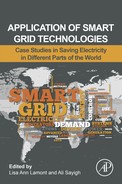Book Description
Application of Smart Grid Technologies: Case Studies in Saving Electricity in Different Parts of the World provides a wide international view of smart grid technologies and their implementation in all regions of the globe. A brief overview of smart grid concepts and state-of-the art technologies is followed by sections that highlight smart grid experiences in Asia, Africa, North America, South America, Europe and Australasia. Chapters address select countries or sub-regions, presenting their local technological needs and specificities, status of smart grid implementation, technologies of choice, impacts on their electricity markets, and future trends. Similar chapter makes it easier to compare these experiences.
In a time when the smart grid is becoming a worldwide reality, this book is ideal for professionals in power transmission and distribution companies, as well as students and researchers in the same field. It is also useful for those involved in energy management and policymaking.
- Presents the status and challenges of smart grid technologies and their implementation around the globe
- Includes global case studies written by local experts and organized for easy comparison
- Provides a brief overview of smart grid concepts and currently available technologies
